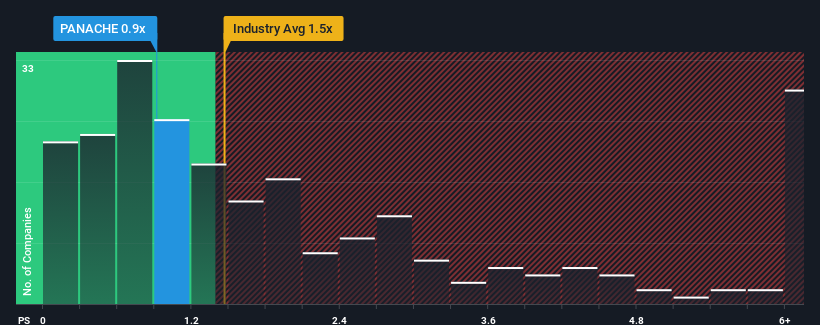- India
- /
- Tech Hardware
- /
- NSEI:PANACHE
There Is A Reason Panache Digilife Limited's (NSE:PANACHE) Price Is Undemanding
With a price-to-sales (or "P/S") ratio of 0.9x Panache Digilife Limited (NSE:PANACHE) may be sending bullish signals at the moment, given that almost half of all the Tech companies in India have P/S ratios greater than 1.9x and even P/S higher than 16x are not unusual. Nonetheless, we'd need to dig a little deeper to determine if there is a rational basis for the reduced P/S.
Check out our latest analysis for Panache Digilife

What Does Panache Digilife's P/S Mean For Shareholders?
As an illustration, revenue has deteriorated at Panache Digilife over the last year, which is not ideal at all. Perhaps the market believes the recent revenue performance isn't good enough to keep up the industry, causing the P/S ratio to suffer. However, if this doesn't eventuate then existing shareholders may be feeling optimistic about the future direction of the share price.
Want the full picture on earnings, revenue and cash flow for the company? Then our free report on Panache Digilife will help you shine a light on its historical performance.Do Revenue Forecasts Match The Low P/S Ratio?
There's an inherent assumption that a company should underperform the industry for P/S ratios like Panache Digilife's to be considered reasonable.
Retrospectively, the last year delivered a frustrating 9.9% decrease to the company's top line. This has soured the latest three-year period, which nevertheless managed to deliver a decent 10% overall rise in revenue. Accordingly, while they would have preferred to keep the run going, shareholders would be roughly satisfied with the medium-term rates of revenue growth.
Comparing the recent medium-term revenue trends against the industry's one-year growth forecast of 17% shows it's noticeably less attractive.
With this in consideration, it's easy to understand why Panache Digilife's P/S falls short of the mark set by its industry peers. It seems most investors are expecting to see the recent limited growth rates continue into the future and are only willing to pay a reduced amount for the stock.
What We Can Learn From Panache Digilife's P/S?
Generally, our preference is to limit the use of the price-to-sales ratio to establishing what the market thinks about the overall health of a company.
In line with expectations, Panache Digilife maintains its low P/S on the weakness of its recent three-year growth being lower than the wider industry forecast. Right now shareholders are accepting the low P/S as they concede future revenue probably won't provide any pleasant surprises. Unless the recent medium-term conditions improve, they will continue to form a barrier for the share price around these levels.
There are also other vital risk factors to consider and we've discovered 4 warning signs for Panache Digilife (2 are a bit unpleasant!) that you should be aware of before investing here.
If companies with solid past earnings growth is up your alley, you may wish to see this free collection of other companies with strong earnings growth and low P/E ratios.
New: Manage All Your Stock Portfolios in One Place
We've created the ultimate portfolio companion for stock investors, and it's free.
• Connect an unlimited number of Portfolios and see your total in one currency
• Be alerted to new Warning Signs or Risks via email or mobile
• Track the Fair Value of your stocks
Have feedback on this article? Concerned about the content? Get in touch with us directly. Alternatively, email editorial-team (at) simplywallst.com.
This article by Simply Wall St is general in nature. We provide commentary based on historical data and analyst forecasts only using an unbiased methodology and our articles are not intended to be financial advice. It does not constitute a recommendation to buy or sell any stock, and does not take account of your objectives, or your financial situation. We aim to bring you long-term focused analysis driven by fundamental data. Note that our analysis may not factor in the latest price-sensitive company announcements or qualitative material. Simply Wall St has no position in any stocks mentioned.
About NSEI:PANACHE
Panache Digilife
Designs, manufactures, distributes, sells, and services ICT and IoT devices in India.
Excellent balance sheet with acceptable track record.
Similar Companies
Market Insights
Community Narratives



